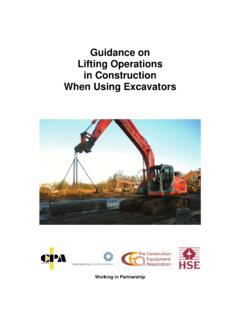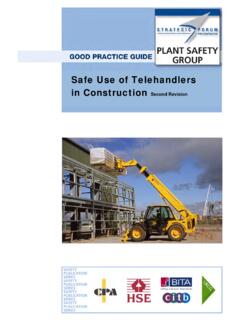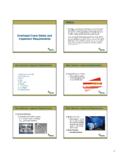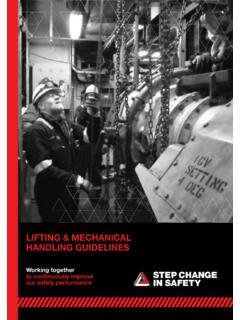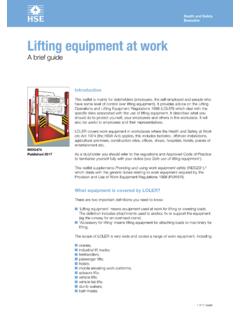Transcription of Guidance on Lifting Operations in Construction When Using ...
1 Guidance on Lifting Operations in Construction When Using Excavators Working in Partnership 21. Introduction The use of excavators for Lifting Operations , particularly on Construction sites, has become more common over the last few years. Excavators and backhoes are designed for rapid earth moving and are not designed for Lifting Operations as their principal function. When planning a Lifting operation, you should firstly consider whether an excavator is the most appropriate machine, taking into account the type of lift and the duration of the task. The purpose of this document is to set out precautions and procedures that should be taken into account when planning and carrying out Lifting Operations with excavators and other types of earth moving equipment (backhoe and loaders) to enable the work to be done safely and in accordance with your legal duties. 2. Particular Hazards Associated with Lifting with Excavators The use of an excavator or backhoe for Lifting creates additional hazards for personnel in the vicinity.
2 Under normal circumstances, personnel are kept away from the working area around the bucket of an excavator, as this is considered to be a hazardous area. Where the excavator is used for object handling however, the slinger has to be in the danger area in order to hook the load on to the hooking device. This puts the slinger at risk of being struck by the load, bucket or excavator arm if the excavator moves without warning. One common incident of this type is where the excavator slews rapidly, for example when the operator catches the cuff of his coat on the left hand joystick, and the ground worker is struck by the bucket or dipper arm or crushed between the dipper arm and a fixed object. Injuries are usually severe in these cases. Excavator operators and slingers should be made aware of these dangers and effective communications must always be maintained between slinger and operator. The excavator operator should always make use of the safety lever (safety armrest) whenever the slinger is in the danger area.
3 Traveling with a suspended load is particularly hazardous. The pre- Lifting risk assessment should ensure that the hazards associated with this operation are fully considered, particularly the presence of personnel adjacent to the machine s travel path. 3. Lifting of Persons with Excavators Excavators should not be used under any circumstances for the Lifting of persons as they are primarily designed for excavating with a bucket and consequently are capable of operating speeds and movements which make them totally unsuitable for the Lifting of persons. Access to height on Construction sites should be by machines designed for the purpose of Lifting persons such as MEWPs, mast climbing work platforms, suspended access platforms or passenger/goods hoists, or by the use of scaffolds. In exceptional circumstances and where it is not reasonably practicable to achieve access by less hazardous means, a suitable crane with a man-riding basket may be used in accordance with Clause of BS 7121:2006 - Code of practice for safe use of cranes Part 1: General.
4 34. Planning of Lifting Operations with Excavators Regulation 8 of LOLER requires Lifting Operations to be properly planned, appropriately supervised and carried out in a safe manner, and this includes Lifting by earth moving machinery. The competent person (See LOLER ACOP and Guidance para. 220 223) should first carry out a risk assessment, which will include ensuring that the earth moving machinery is suitable for the task, that adequate Lifting accessories are available and the ground conditions are suitable. The Lifting accessories, including quick hitches, should be suitable for the load and marked with their safe working load. The risk assessment will also address the need to segregate the Lifting operation from other persons on site. Based on this risk assessment, a written method statement setting out the safe operating procedure to be followed should be prepared and communicated to all personnel involved in the Lifting operation.
5 NOTE: For employers with 5 or more employees, the significant findings of the risk assessment must be recorded. The significant findings should include who is at risk, why they are at risk and how that risk is controlled. A comprehensive method statement could include this information. Special attachments for Lifting (or other uses) should be compatible with the machine and coupling means (quick-hitch) to which they are being attached. A competent person should verify that the combination is designed to take the load in this manner. Further Guidance on planning Lifting Operations is given in BS 7121-1:2006. 5. Lifting Operations Before Lifting Operations begin it is essential that all personnel involved are fully briefed on the significant findings of the risk assessment, the method statement and their individual roles in carrying out the task. The supervisor should ensure that persons are kept well away from the Lifting area, and in particular that there is no one working below the lift, for example in a trench.
6 Personnel should wear hi-visibility clothing and other appropriate PPE. Excavator operators must never move the machine or load until they have satisfied themselves that the slinger/signaler and any other persons associated with the lift have all moved away from the danger area, to a position of safety. The slinger or operator should check the Lifting accessories, including the Lifting point, before use to ensure they are not damaged or worn. Any defective Lifting accessories should be removed from service immediately. Chain slings should not have any distorted links or components, hooks should not be bent and the safety clip should be in working condition. Fibre slings should be rejected when damaged, and in any case when the outer covering is worn to the extent that the inner cores are visible. Where the hooking device (the point on the machine designed for connection of the load) is not part of the bucket, the bucket should (where possible, and unless the operator instructions specify otherwise) be removed in order to improve visibility and reduce the weight being lifted.
7 If the bucket is retained, then the weight of both the bucket and quick-hitch has to be added to the load when determining whether the load is within the rated capacity. When attaching Lifting slings to the hooking device or Lifting point care should be taken to ensure that the slings and their attachments are able to hang free at all times. Attachment Using a shackle may limit rotation if, for example, a pipe suspended from the slings is to be turned end for end (See Fig. 1). Fig. 2 shows the addition of a swivel to overcome this problem. Similarly, if the quick hitch is tilted backwards and/or the dipper arm is raised, the master link of the sling and any attachments may be put into bending or twisting possibly leading to damage or failure (See Figs. 3 & 4). These issues may reduce the height to which a load may be lifted to less than that indicated in the machine s rated object handling capacity table. The excavator operator should ensure that the acoustic/visual warning device indicating the load moment, is switched on prior to any Lifting operation.
8 4 NOTE: Advice on the planning and carrying out of Lifting Operations is given in Lifting Operations : An explanation of LOLER published by Construction Industry Press. Figure 1 - Master link rotation restricted to approx 70 Figure 2. Swivel allows unrestricted rotation but reduces available headroom Bad Practice Figure 3 Hitch tilted backwards with master link subject to bending Figure 4 Hitch tilted backwards with master link subject to twisting Good Practice Figure 5 Chain and master link can hang freely without obstruction 6. Excavator Requirements when Used for Lifting The design of earth moving machinery for Lifting (object handling) is covered by the European standard BS EN 474 parts 1, 3, 4 and 5 (see bibliography). Any earth-moving machine designed for object handling should have a rated object handling capacity table available inside the cab. An example is shown in Fig.
9 6. If a rated 5object handling capacity table is not available then the machine should not be used for object handling. NOTE: Handling attachments ( grab) that do not require the assistance of a person for hooking or guiding are considered as normal earth moving Operations and do not require warning devices and a rated capacity table. An earth-moving machine used for Lifting Operations must be fitted with a load hooking device. This may be mounted on the dipper, the quick hitch or the bucket. If the load hooking device is a hook then this should have a clip or other device which prevents a sling slipping off the hook. Many quick-hitches provide a load hooking device in the design of the hitch. If the rated Lifting capacity for an excavator or the backhoe portion of a backhoe-loader is greater than 1 tonne (or the overturning moment is greater than 40000Nm) then the machine must be fitted with: a) a boom lowering control device on the raising (main) boom cylinder(s) and which meets the requirements of ISO 8643:1997 and b) an acoustic or visual warning device which indicates to the operator when the object handling capacity or corresponding load moment is reached NOTE: Loaders and the loader portion of a backhoe/loader do not require a boom lowering control device or acoustic/ visual warning devices.
10 NOTE: Where a risk assessment shows that there is a significant risk of overloading and/or overturning on machines with a rated capacity of 1 tonne or less, a Rated Capacity Indicator may be required. (See LOLER ACOP and Guidance paragraph 122). Suitable slings must be available to attach the load to the excavator. Slings and other Lifting accessories should be CE marked, and marked with the safe working load. 7. Training and Competency Assessment Excavator drivers and slingers should be adequately trained and assessed to undertake their roles in Lifting Operations . This training is additional to the training required for operating the machine as an excavator. Suitable Guidance is available in BS 7121 parts 1 and 3. NOTE: Prior to 2008, the CPCS category for excavator operation does not cover Lifting Operations . The current CPCS category has been amended to include Lifting objects and will apply to all those taking the practical and theory tests from 1st August 2008.
